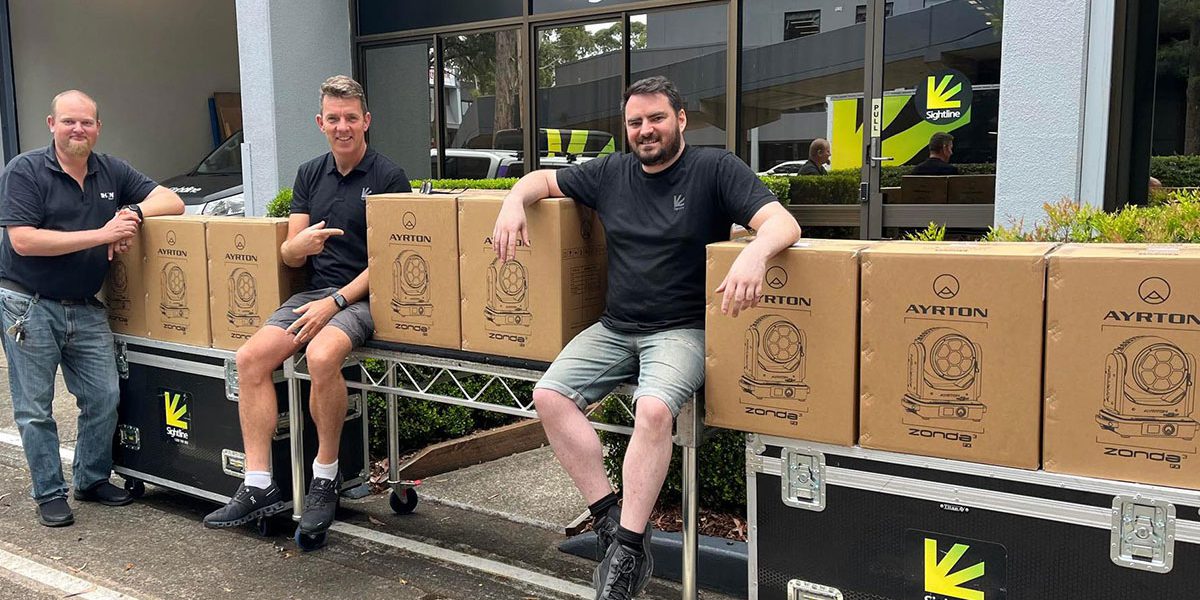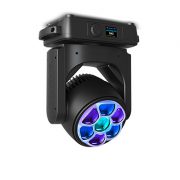Sightline is always looking to improve our inventory. In 2023, we had been looking for a smallish lighting fixture that was multi-function, and tested a whole heap of different units. Our director Joe Murray was keen on the bigger Zonda 9 but I couldn’t really justify the expense at that time. It seemed like a lot of money for just a couple of LEDs pointing at a screen.
We’ve been using Mac Aura’s as our go-to small light but they were getting old and really needed a replacement. We like to do different ideas for sets and looks, so a small versatile unit is a fairly quick way to just chuck something onstage and have it look different.
We investigated many similar fixtures and there are a lot available but only one ticked every box. Basically, the Zonda 3 FX is the only one that can do everything I want it to do. I wanted great zoom, great colour, high speed, and pixel control of everything. It also needed to just look good onstage as eye candy. I really like the look of the front – I think it’s very unique. I generally like to have them somewhere they are seen. Even if they are on the rear truss doing a backlight, you can still – when they are not doing a stage wash – have them doing something nice and pretty and actually be good to look at.
The Zonda 3 FXs really come into their own when you use them in multiples. People have seen every light under the sun these days so a unique new thing that we can do is pixel mapping with lots of fixtures. The pixel definition of these units is awesome. When you get a bunch of them together and they are mapped properly, you can tell it meshes seamlessly between all the fixtures. It looks pretty impressive, to be honest.
On paper, they may not seem that bright (at 5200 lumens) but every manufacturer seems to run a different testing routine. In person, they are super bright. I’ve had them running next to Auroras and these 3 FX seem twice as intense. Colour reproduction is really good too. Even single colour beams are very bright. However, it only has a CRI of 86, so it’s not a unit that I would use when there are cameras involved.
Three DMX modes are handy and we sometimes use the 79 channel one for pixel map jobs. I’ve made a map of every parameter for the MA console and the liquid effect for the 3 FX takes a full universe of 415 channels, so it’s easier to use Mode3 DMX to achieve the same thing. I’ve been using a software program called MadMapper that lets me basically map out where the fixtures are, overlay video feeds and play them really quickly. This does need ARTNet support, so you require both DMX and CAT5 runs to each unit if you want liquid effects.
The Zonda 3 FX are small but robust and seem fairly heavy for their size. But the motors must be pretty good, because they are very fast and responsive. The 3 FX also come with an arm- locking feature to stop them spinning around when you are rigging or packing them away.
There is a silent mode available, and I tested it on a bar show one night: they ran fine without overheating.
My big gripe is the use of a jog wheel for navigating menu settings. I much prefer discrete buttons, but this wheel works ok for what it is.
The Zonda FX 3 is versatile enough that it can do all the fancy things that some lights can do and some that other lights can’t, and these basically knocked everything else out of the water. We use them on a lot of jobs now.
I would still love an even smaller fixture – maybe something that you can actually hold in your hand, with one LED that’s bright enough. You could chuck up a heap of them. If anyone wants to make a battery powered and wireless one, I would probably buy 100 of them straight away.
In the meantime, I’ll keep leaning on the excellent support from Show Technology and using plenty of Zonda 3 FX while I’m waiting for them to come up with the ultimate small universal.
Written by Steven Hill, Head of Lighting, Sightline Productions


